Marketing Management Report: Competition and Marketing Strategies
VerifiedAdded on 2022/08/21
|7
|1085
|11
Report
AI Summary
This report addresses key aspects of marketing management, including the roles and functions of marketing intermediaries such as agents, wholesalers, distributors, and retailers, highlighting their significance for both large and small businesses. It explores how additional marketing channels, such as email, display, social media, and affiliate marketing, can enhance market reach. The report also analyzes the pros and cons of social media marketing, emphasizing its impact on brand recognition, cost efficiency, and the risks associated with negative publicity and privacy violations. It provides examples like HP and Dell to illustrate the practical application of these strategies. Furthermore, the report discusses the importance of evaluating competition and refining market positions, supported by a scholarly article on information technology's role in gaining competitive advantages. The analysis underscores the need for continuous research and innovation to meet customer demands and achieve strategic market positioning.
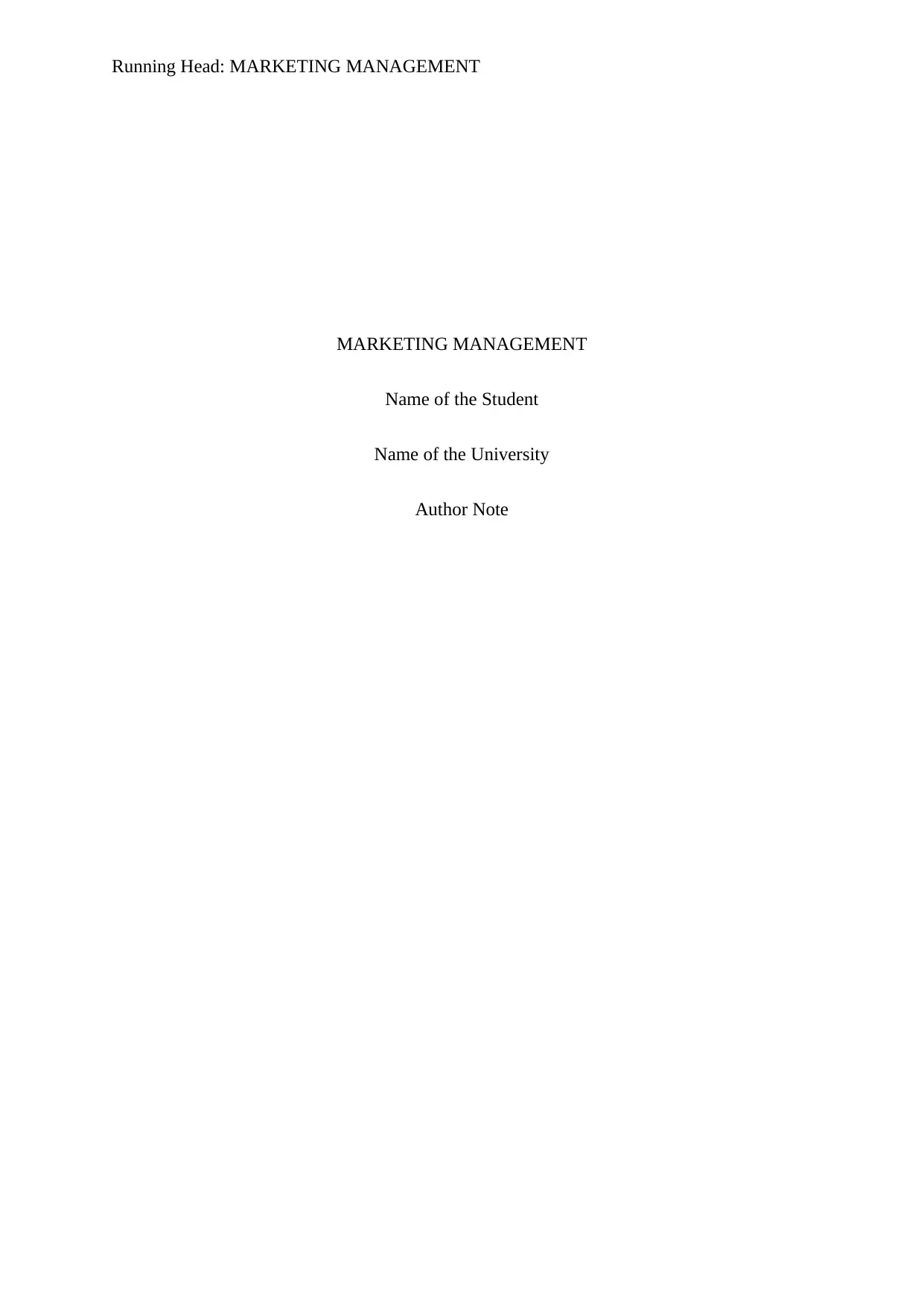
Running Head: MARKETING MANAGEMENT
MARKETING MANAGEMENT
Name of the Student
Name of the University
Author Note
MARKETING MANAGEMENT
Name of the Student
Name of the University
Author Note
Paraphrase This Document
Need a fresh take? Get an instant paraphrase of this document with our AI Paraphraser

1MARKETING MANAGEMENT
Table of Contents
Answer to question 1..................................................................................................................2
Answer to question 2..................................................................................................................3
Answer to question 3..................................................................................................................4
References..................................................................................................................................6
Table of Contents
Answer to question 1..................................................................................................................2
Answer to question 2..................................................................................................................3
Answer to question 3..................................................................................................................4
References..................................................................................................................................6
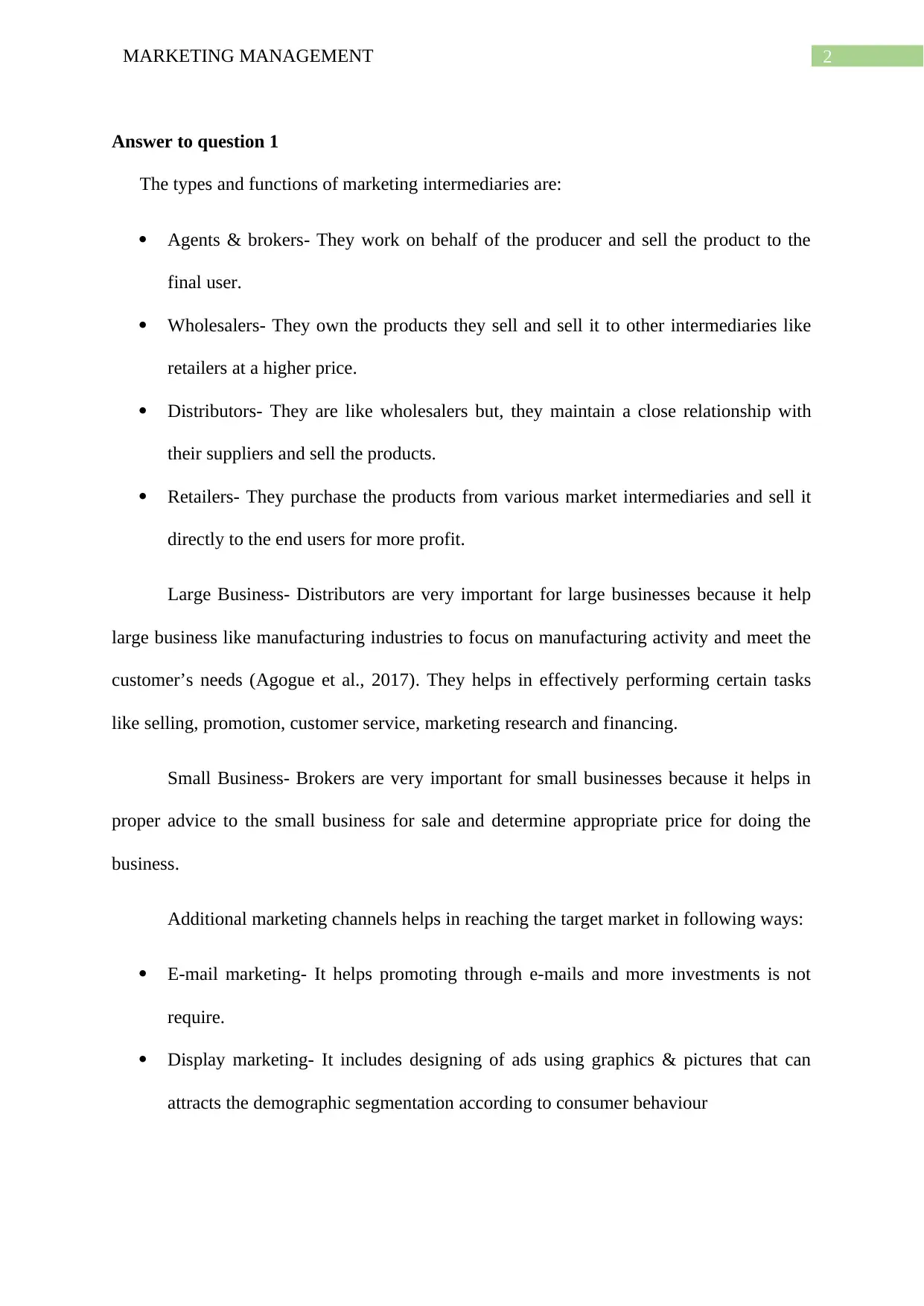
2MARKETING MANAGEMENT
Answer to question 1
The types and functions of marketing intermediaries are:
Agents & brokers- They work on behalf of the producer and sell the product to the
final user.
Wholesalers- They own the products they sell and sell it to other intermediaries like
retailers at a higher price.
Distributors- They are like wholesalers but, they maintain a close relationship with
their suppliers and sell the products.
Retailers- They purchase the products from various market intermediaries and sell it
directly to the end users for more profit.
Large Business- Distributors are very important for large businesses because it help
large business like manufacturing industries to focus on manufacturing activity and meet the
customer’s needs (Agogue et al., 2017). They helps in effectively performing certain tasks
like selling, promotion, customer service, marketing research and financing.
Small Business- Brokers are very important for small businesses because it helps in
proper advice to the small business for sale and determine appropriate price for doing the
business.
Additional marketing channels helps in reaching the target market in following ways:
E-mail marketing- It helps promoting through e-mails and more investments is not
require.
Display marketing- It includes designing of ads using graphics & pictures that can
attracts the demographic segmentation according to consumer behaviour
Answer to question 1
The types and functions of marketing intermediaries are:
Agents & brokers- They work on behalf of the producer and sell the product to the
final user.
Wholesalers- They own the products they sell and sell it to other intermediaries like
retailers at a higher price.
Distributors- They are like wholesalers but, they maintain a close relationship with
their suppliers and sell the products.
Retailers- They purchase the products from various market intermediaries and sell it
directly to the end users for more profit.
Large Business- Distributors are very important for large businesses because it help
large business like manufacturing industries to focus on manufacturing activity and meet the
customer’s needs (Agogue et al., 2017). They helps in effectively performing certain tasks
like selling, promotion, customer service, marketing research and financing.
Small Business- Brokers are very important for small businesses because it helps in
proper advice to the small business for sale and determine appropriate price for doing the
business.
Additional marketing channels helps in reaching the target market in following ways:
E-mail marketing- It helps promoting through e-mails and more investments is not
require.
Display marketing- It includes designing of ads using graphics & pictures that can
attracts the demographic segmentation according to consumer behaviour
⊘ This is a preview!⊘
Do you want full access?
Subscribe today to unlock all pages.

Trusted by 1+ million students worldwide
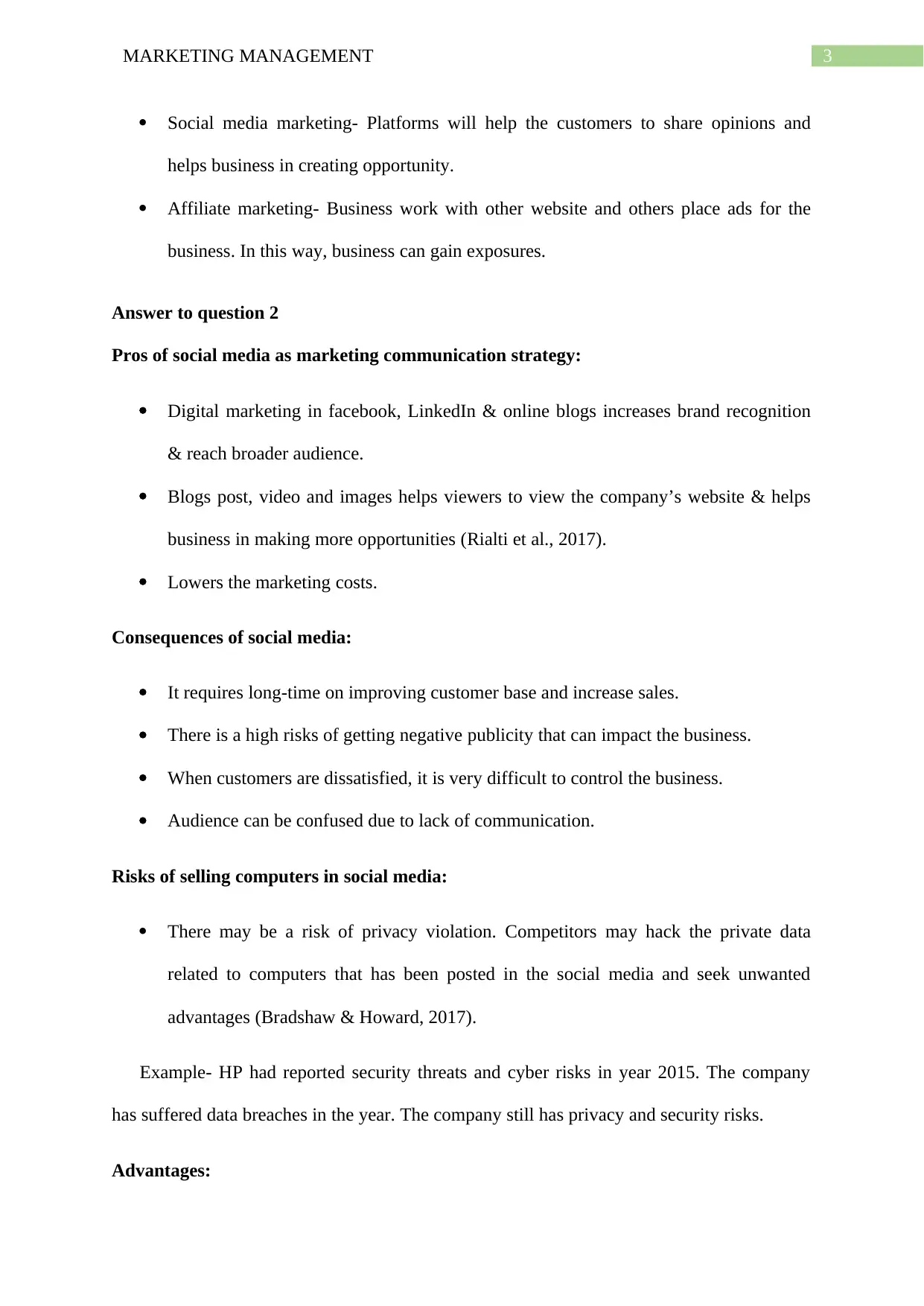
3MARKETING MANAGEMENT
Social media marketing- Platforms will help the customers to share opinions and
helps business in creating opportunity.
Affiliate marketing- Business work with other website and others place ads for the
business. In this way, business can gain exposures.
Answer to question 2
Pros of social media as marketing communication strategy:
Digital marketing in facebook, LinkedIn & online blogs increases brand recognition
& reach broader audience.
Blogs post, video and images helps viewers to view the company’s website & helps
business in making more opportunities (Rialti et al., 2017).
Lowers the marketing costs.
Consequences of social media:
It requires long-time on improving customer base and increase sales.
There is a high risks of getting negative publicity that can impact the business.
When customers are dissatisfied, it is very difficult to control the business.
Audience can be confused due to lack of communication.
Risks of selling computers in social media:
There may be a risk of privacy violation. Competitors may hack the private data
related to computers that has been posted in the social media and seek unwanted
advantages (Bradshaw & Howard, 2017).
Example- HP had reported security threats and cyber risks in year 2015. The company
has suffered data breaches in the year. The company still has privacy and security risks.
Advantages:
Social media marketing- Platforms will help the customers to share opinions and
helps business in creating opportunity.
Affiliate marketing- Business work with other website and others place ads for the
business. In this way, business can gain exposures.
Answer to question 2
Pros of social media as marketing communication strategy:
Digital marketing in facebook, LinkedIn & online blogs increases brand recognition
& reach broader audience.
Blogs post, video and images helps viewers to view the company’s website & helps
business in making more opportunities (Rialti et al., 2017).
Lowers the marketing costs.
Consequences of social media:
It requires long-time on improving customer base and increase sales.
There is a high risks of getting negative publicity that can impact the business.
When customers are dissatisfied, it is very difficult to control the business.
Audience can be confused due to lack of communication.
Risks of selling computers in social media:
There may be a risk of privacy violation. Competitors may hack the private data
related to computers that has been posted in the social media and seek unwanted
advantages (Bradshaw & Howard, 2017).
Example- HP had reported security threats and cyber risks in year 2015. The company
has suffered data breaches in the year. The company still has privacy and security risks.
Advantages:
Paraphrase This Document
Need a fresh take? Get an instant paraphrase of this document with our AI Paraphraser
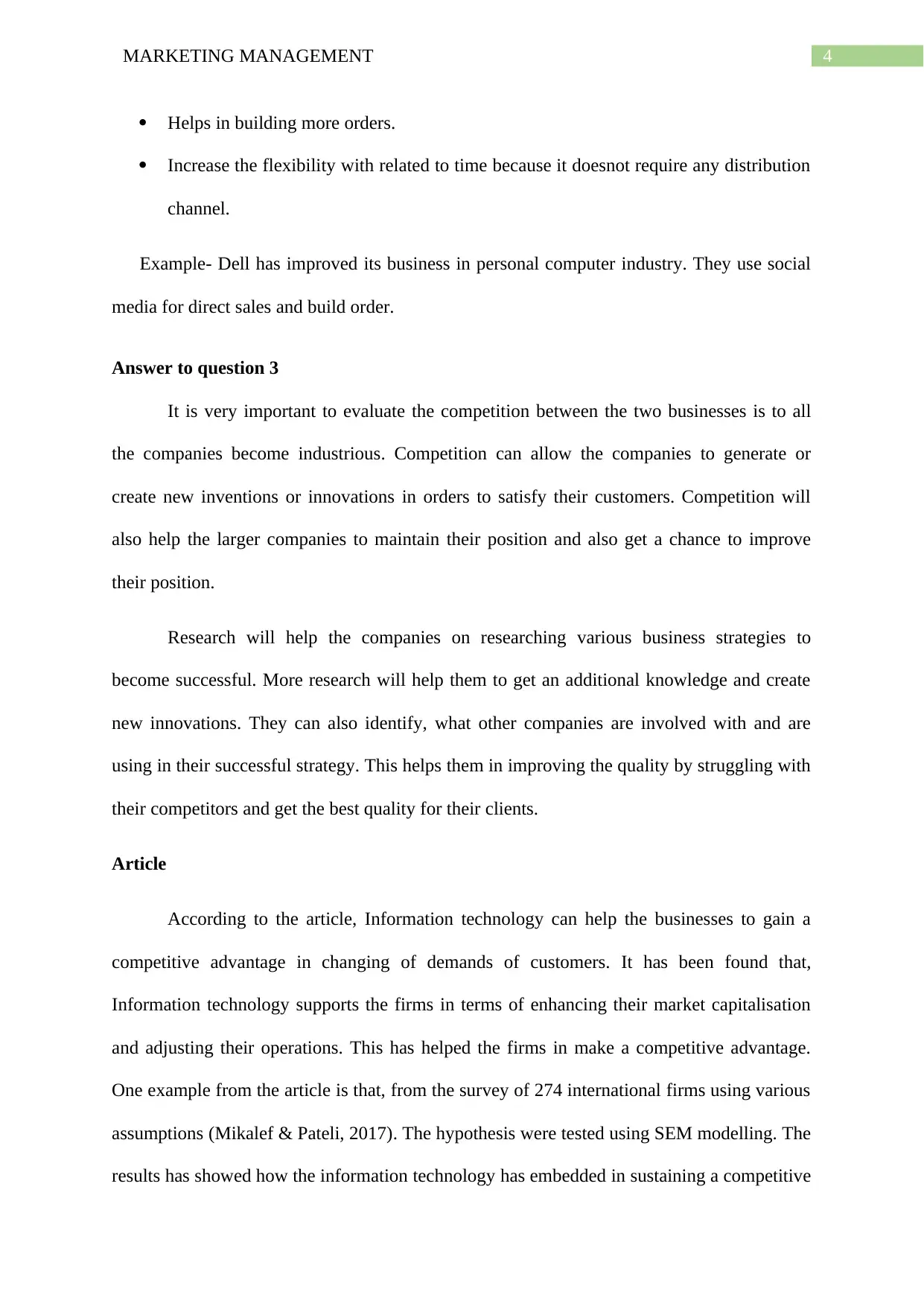
4MARKETING MANAGEMENT
Helps in building more orders.
Increase the flexibility with related to time because it doesnot require any distribution
channel.
Example- Dell has improved its business in personal computer industry. They use social
media for direct sales and build order.
Answer to question 3
It is very important to evaluate the competition between the two businesses is to all
the companies become industrious. Competition can allow the companies to generate or
create new inventions or innovations in orders to satisfy their customers. Competition will
also help the larger companies to maintain their position and also get a chance to improve
their position.
Research will help the companies on researching various business strategies to
become successful. More research will help them to get an additional knowledge and create
new innovations. They can also identify, what other companies are involved with and are
using in their successful strategy. This helps them in improving the quality by struggling with
their competitors and get the best quality for their clients.
Article
According to the article, Information technology can help the businesses to gain a
competitive advantage in changing of demands of customers. It has been found that,
Information technology supports the firms in terms of enhancing their market capitalisation
and adjusting their operations. This has helped the firms in make a competitive advantage.
One example from the article is that, from the survey of 274 international firms using various
assumptions (Mikalef & Pateli, 2017). The hypothesis were tested using SEM modelling. The
results has showed how the information technology has embedded in sustaining a competitive
Helps in building more orders.
Increase the flexibility with related to time because it doesnot require any distribution
channel.
Example- Dell has improved its business in personal computer industry. They use social
media for direct sales and build order.
Answer to question 3
It is very important to evaluate the competition between the two businesses is to all
the companies become industrious. Competition can allow the companies to generate or
create new inventions or innovations in orders to satisfy their customers. Competition will
also help the larger companies to maintain their position and also get a chance to improve
their position.
Research will help the companies on researching various business strategies to
become successful. More research will help them to get an additional knowledge and create
new innovations. They can also identify, what other companies are involved with and are
using in their successful strategy. This helps them in improving the quality by struggling with
their competitors and get the best quality for their clients.
Article
According to the article, Information technology can help the businesses to gain a
competitive advantage in changing of demands of customers. It has been found that,
Information technology supports the firms in terms of enhancing their market capitalisation
and adjusting their operations. This has helped the firms in make a competitive advantage.
One example from the article is that, from the survey of 274 international firms using various
assumptions (Mikalef & Pateli, 2017). The hypothesis were tested using SEM modelling. The
results has showed how the information technology has embedded in sustaining a competitive
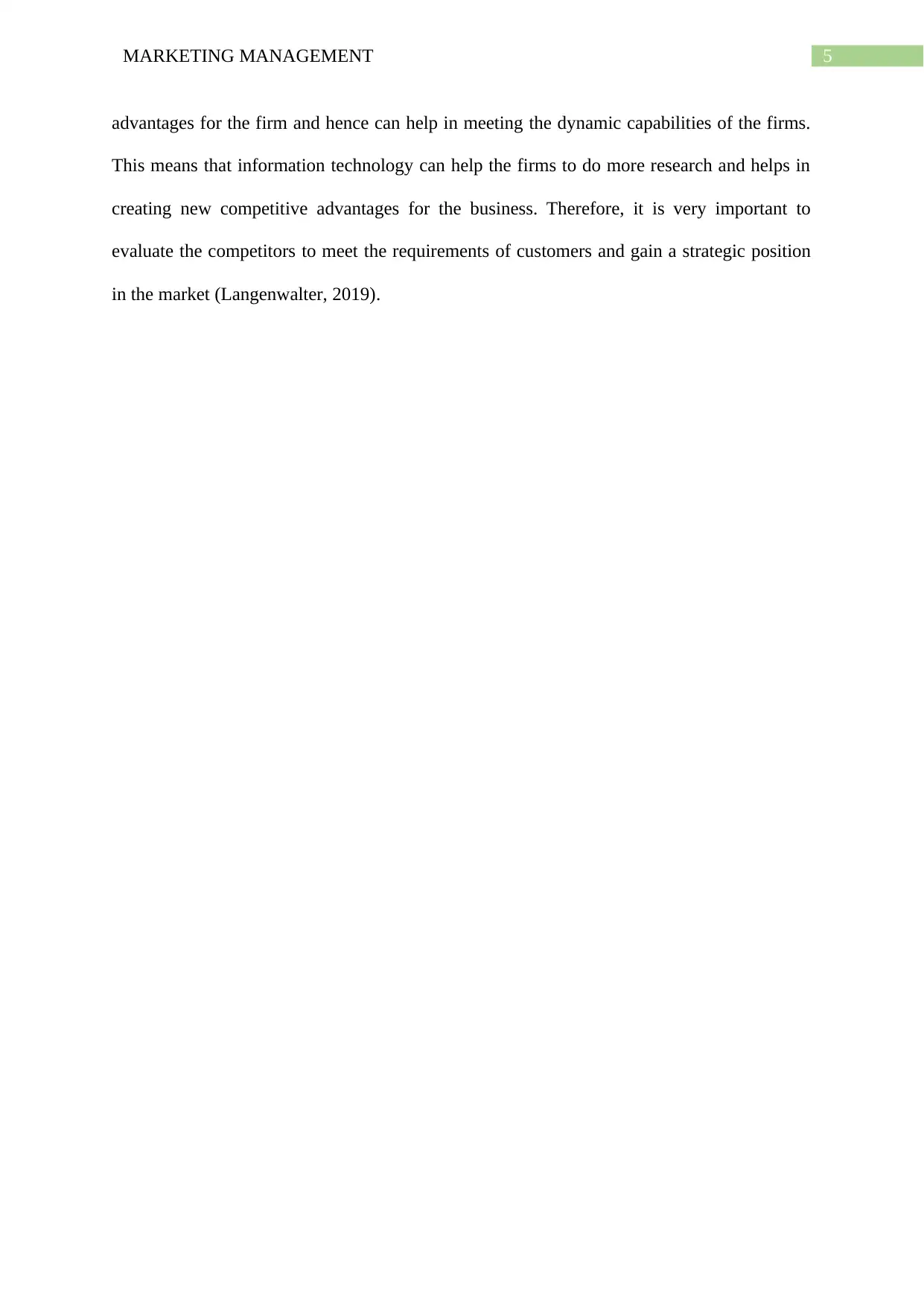
5MARKETING MANAGEMENT
advantages for the firm and hence can help in meeting the dynamic capabilities of the firms.
This means that information technology can help the firms to do more research and helps in
creating new competitive advantages for the business. Therefore, it is very important to
evaluate the competitors to meet the requirements of customers and gain a strategic position
in the market (Langenwalter, 2019).
advantages for the firm and hence can help in meeting the dynamic capabilities of the firms.
This means that information technology can help the firms to do more research and helps in
creating new competitive advantages for the business. Therefore, it is very important to
evaluate the competitors to meet the requirements of customers and gain a strategic position
in the market (Langenwalter, 2019).
⊘ This is a preview!⊘
Do you want full access?
Subscribe today to unlock all pages.

Trusted by 1+ million students worldwide
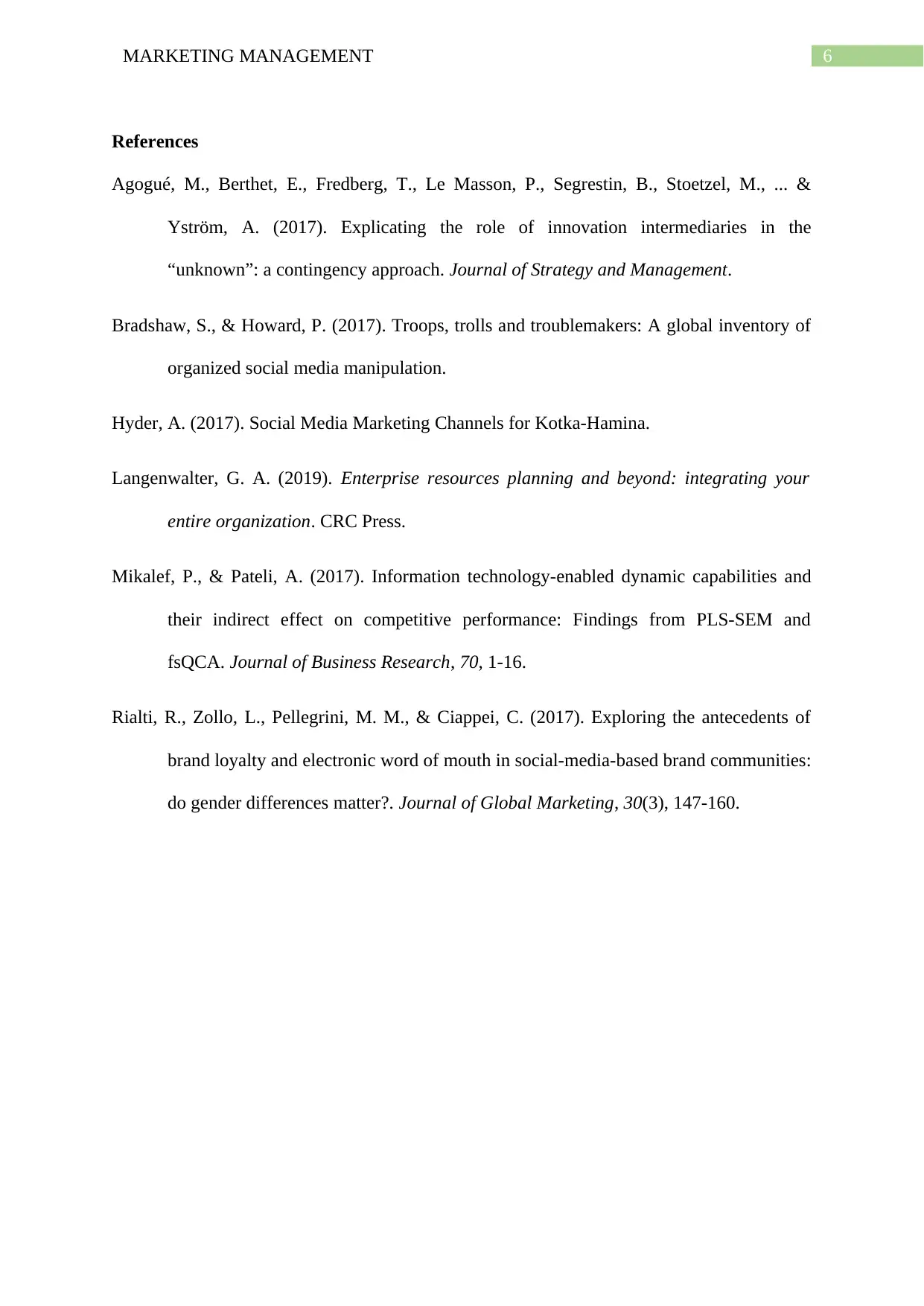
6MARKETING MANAGEMENT
References
Agogué, M., Berthet, E., Fredberg, T., Le Masson, P., Segrestin, B., Stoetzel, M., ... &
Yström, A. (2017). Explicating the role of innovation intermediaries in the
“unknown”: a contingency approach. Journal of Strategy and Management.
Bradshaw, S., & Howard, P. (2017). Troops, trolls and troublemakers: A global inventory of
organized social media manipulation.
Hyder, A. (2017). Social Media Marketing Channels for Kotka-Hamina.
Langenwalter, G. A. (2019). Enterprise resources planning and beyond: integrating your
entire organization. CRC Press.
Mikalef, P., & Pateli, A. (2017). Information technology-enabled dynamic capabilities and
their indirect effect on competitive performance: Findings from PLS-SEM and
fsQCA. Journal of Business Research, 70, 1-16.
Rialti, R., Zollo, L., Pellegrini, M. M., & Ciappei, C. (2017). Exploring the antecedents of
brand loyalty and electronic word of mouth in social-media-based brand communities:
do gender differences matter?. Journal of Global Marketing, 30(3), 147-160.
References
Agogué, M., Berthet, E., Fredberg, T., Le Masson, P., Segrestin, B., Stoetzel, M., ... &
Yström, A. (2017). Explicating the role of innovation intermediaries in the
“unknown”: a contingency approach. Journal of Strategy and Management.
Bradshaw, S., & Howard, P. (2017). Troops, trolls and troublemakers: A global inventory of
organized social media manipulation.
Hyder, A. (2017). Social Media Marketing Channels for Kotka-Hamina.
Langenwalter, G. A. (2019). Enterprise resources planning and beyond: integrating your
entire organization. CRC Press.
Mikalef, P., & Pateli, A. (2017). Information technology-enabled dynamic capabilities and
their indirect effect on competitive performance: Findings from PLS-SEM and
fsQCA. Journal of Business Research, 70, 1-16.
Rialti, R., Zollo, L., Pellegrini, M. M., & Ciappei, C. (2017). Exploring the antecedents of
brand loyalty and electronic word of mouth in social-media-based brand communities:
do gender differences matter?. Journal of Global Marketing, 30(3), 147-160.
1 out of 7
Related Documents
Your All-in-One AI-Powered Toolkit for Academic Success.
+13062052269
info@desklib.com
Available 24*7 on WhatsApp / Email
![[object Object]](/_next/static/media/star-bottom.7253800d.svg)
Unlock your academic potential
Copyright © 2020–2025 A2Z Services. All Rights Reserved. Developed and managed by ZUCOL.




